IS Project Management Report: Threats, Legal, and Closing
VerifiedAdded on 2021/06/15
|12
|3142
|25
Report
AI Summary
This IS project management report delves into the critical aspects of IT project implementation. It begins by outlining the integral role of IS project development in aligning activities for successful project deliverables and highlights key threats such as design flaws, technological feasibility issues, scope and budget constraints, and vendor problems. The report then examines the impact of legal and ethical considerations, alongside cultural differences that can significantly affect project outcomes. Furthermore, the report details the project closing processes, including final report development, system maintenance, and final approvals. The report underscores the importance of addressing these factors for successful project completion and future reference.
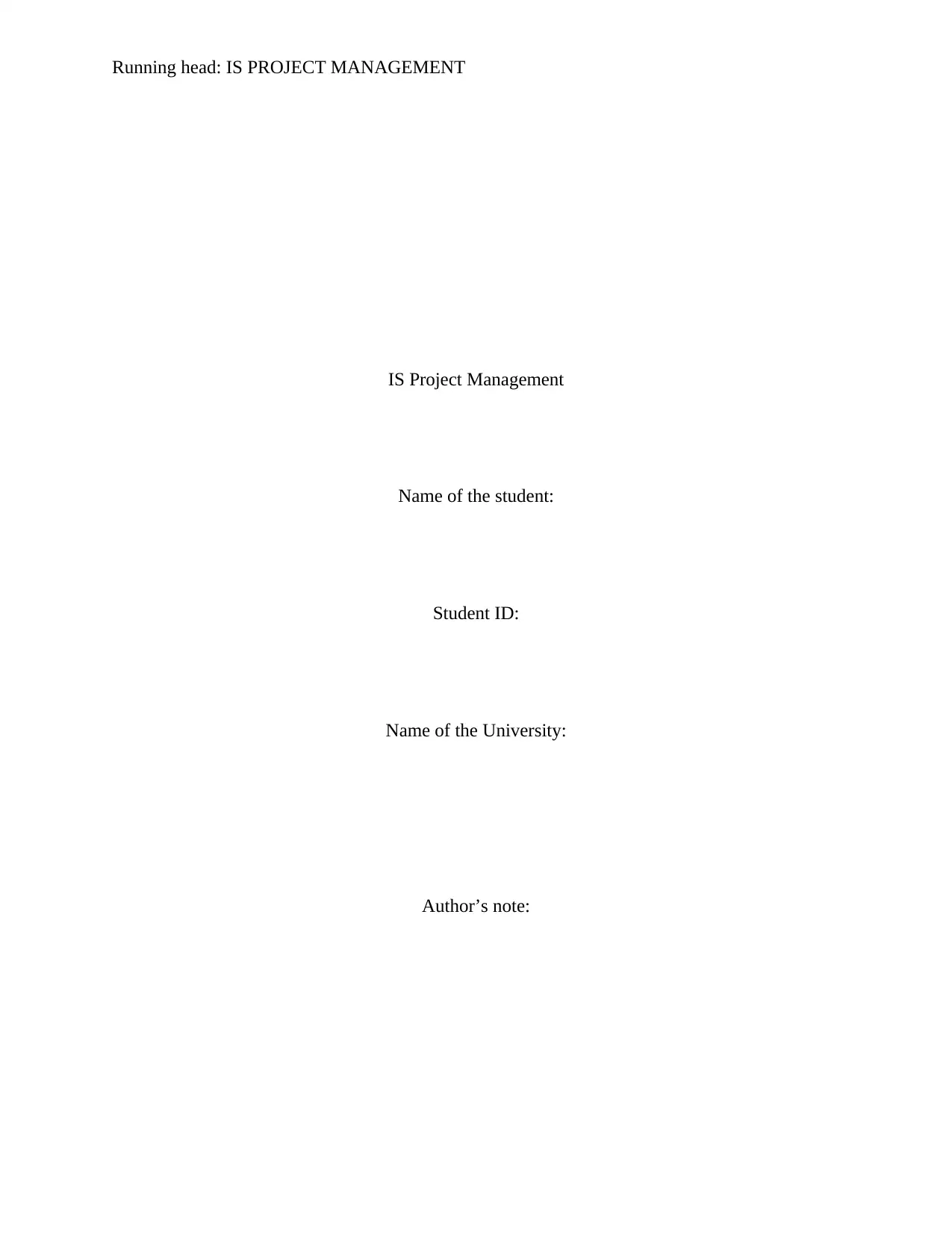
Running head: IS PROJECT MANAGEMENT
IS Project Management
Name of the student:
Student ID:
Name of the University:
Author’s note:
IS Project Management
Name of the student:
Student ID:
Name of the University:
Author’s note:
Paraphrase This Document
Need a fresh take? Get an instant paraphrase of this document with our AI Paraphraser
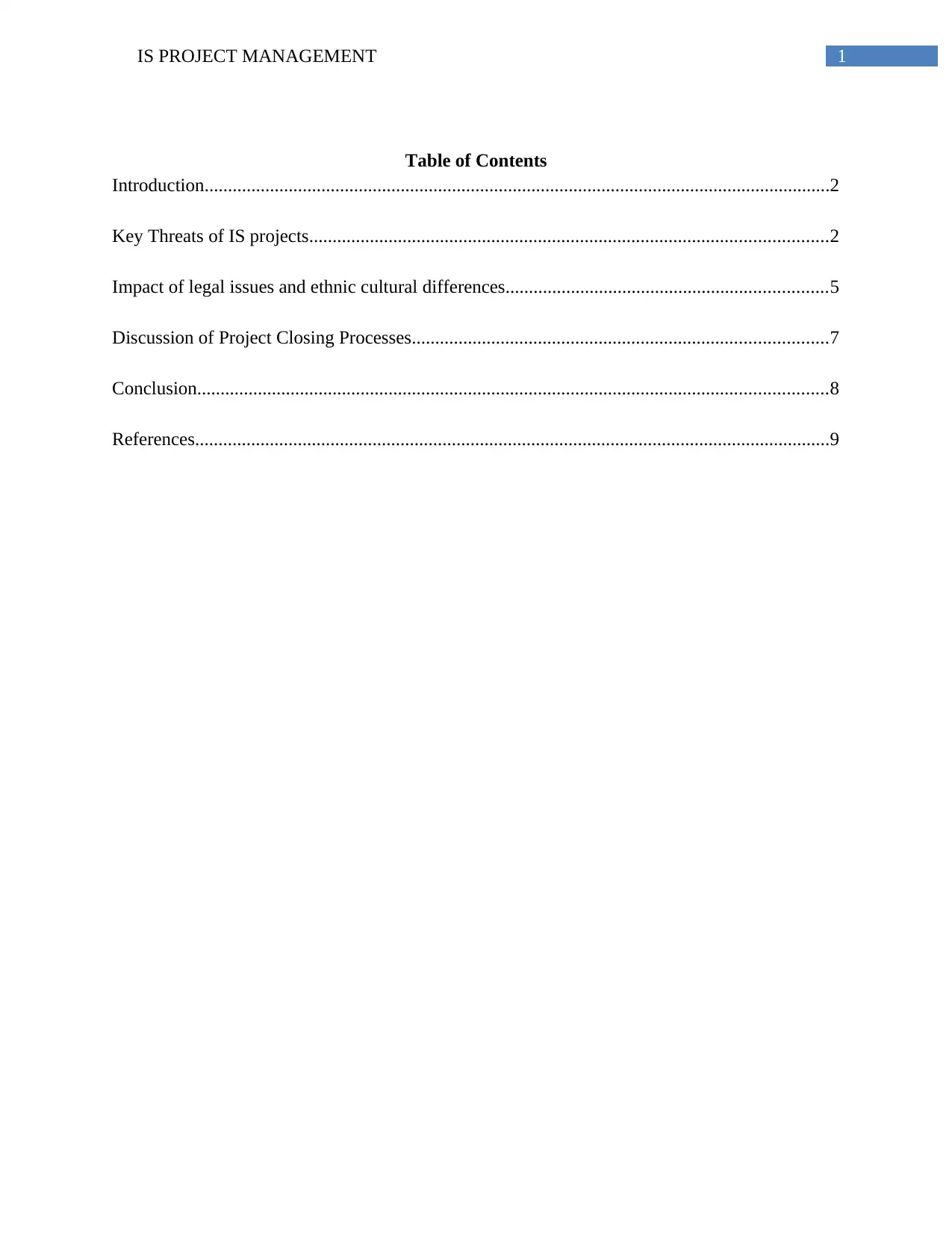
1IS PROJECT MANAGEMENT
Table of Contents
Introduction......................................................................................................................................2
Key Threats of IS projects...............................................................................................................2
Impact of legal issues and ethnic cultural differences.....................................................................5
Discussion of Project Closing Processes.........................................................................................7
Conclusion.......................................................................................................................................8
References........................................................................................................................................9
Table of Contents
Introduction......................................................................................................................................2
Key Threats of IS projects...............................................................................................................2
Impact of legal issues and ethnic cultural differences.....................................................................5
Discussion of Project Closing Processes.........................................................................................7
Conclusion.......................................................................................................................................8
References........................................................................................................................................9
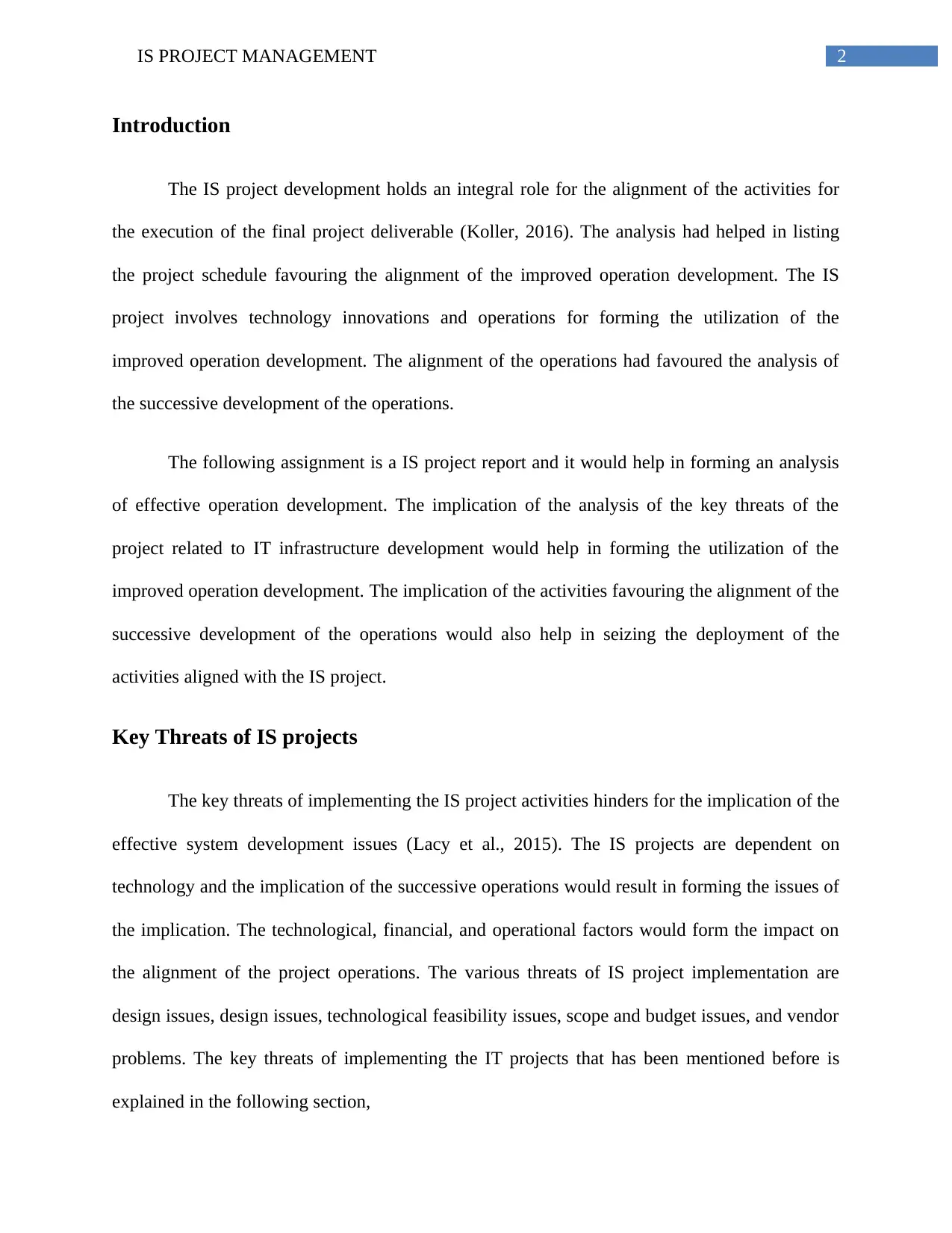
2IS PROJECT MANAGEMENT
Introduction
The IS project development holds an integral role for the alignment of the activities for
the execution of the final project deliverable (Koller, 2016). The analysis had helped in listing
the project schedule favouring the alignment of the improved operation development. The IS
project involves technology innovations and operations for forming the utilization of the
improved operation development. The alignment of the operations had favoured the analysis of
the successive development of the operations.
The following assignment is a IS project report and it would help in forming an analysis
of effective operation development. The implication of the analysis of the key threats of the
project related to IT infrastructure development would help in forming the utilization of the
improved operation development. The implication of the activities favouring the alignment of the
successive development of the operations would also help in seizing the deployment of the
activities aligned with the IS project.
Key Threats of IS projects
The key threats of implementing the IS project activities hinders for the implication of the
effective system development issues (Lacy et al., 2015). The IS projects are dependent on
technology and the implication of the successive operations would result in forming the issues of
the implication. The technological, financial, and operational factors would form the impact on
the alignment of the project operations. The various threats of IS project implementation are
design issues, design issues, technological feasibility issues, scope and budget issues, and vendor
problems. The key threats of implementing the IT projects that has been mentioned before is
explained in the following section,
Introduction
The IS project development holds an integral role for the alignment of the activities for
the execution of the final project deliverable (Koller, 2016). The analysis had helped in listing
the project schedule favouring the alignment of the improved operation development. The IS
project involves technology innovations and operations for forming the utilization of the
improved operation development. The alignment of the operations had favoured the analysis of
the successive development of the operations.
The following assignment is a IS project report and it would help in forming an analysis
of effective operation development. The implication of the analysis of the key threats of the
project related to IT infrastructure development would help in forming the utilization of the
improved operation development. The implication of the activities favouring the alignment of the
successive development of the operations would also help in seizing the deployment of the
activities aligned with the IS project.
Key Threats of IS projects
The key threats of implementing the IS project activities hinders for the implication of the
effective system development issues (Lacy et al., 2015). The IS projects are dependent on
technology and the implication of the successive operations would result in forming the issues of
the implication. The technological, financial, and operational factors would form the impact on
the alignment of the project operations. The various threats of IS project implementation are
design issues, design issues, technological feasibility issues, scope and budget issues, and vendor
problems. The key threats of implementing the IT projects that has been mentioned before is
explained in the following section,
⊘ This is a preview!⊘
Do you want full access?
Subscribe today to unlock all pages.

Trusted by 1+ million students worldwide
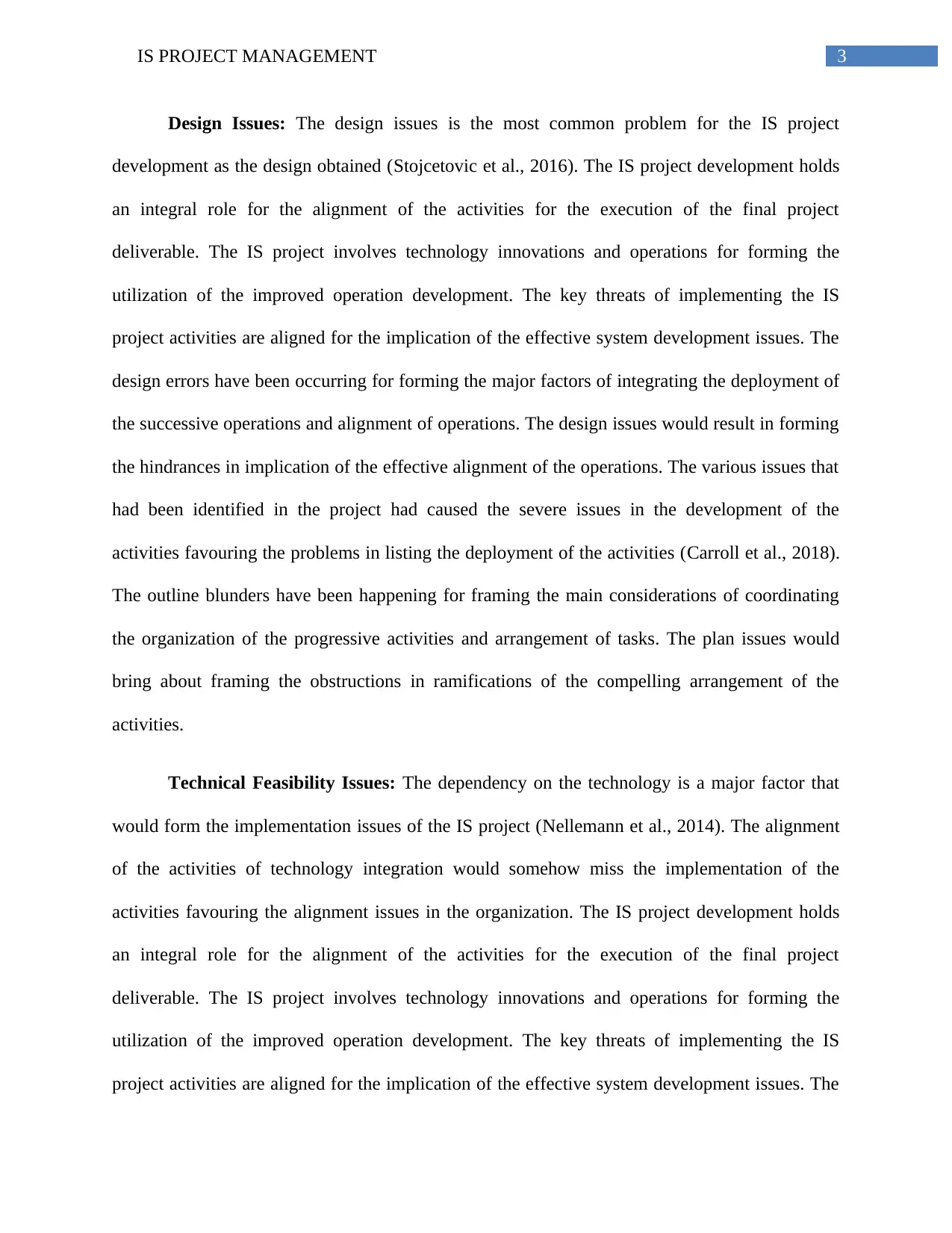
3IS PROJECT MANAGEMENT
Design Issues: The design issues is the most common problem for the IS project
development as the design obtained (Stojcetovic et al., 2016). The IS project development holds
an integral role for the alignment of the activities for the execution of the final project
deliverable. The IS project involves technology innovations and operations for forming the
utilization of the improved operation development. The key threats of implementing the IS
project activities are aligned for the implication of the effective system development issues. The
design errors have been occurring for forming the major factors of integrating the deployment of
the successive operations and alignment of operations. The design issues would result in forming
the hindrances in implication of the effective alignment of the operations. The various issues that
had been identified in the project had caused the severe issues in the development of the
activities favouring the problems in listing the deployment of the activities (Carroll et al., 2018).
The outline blunders have been happening for framing the main considerations of coordinating
the organization of the progressive activities and arrangement of tasks. The plan issues would
bring about framing the obstructions in ramifications of the compelling arrangement of the
activities.
Technical Feasibility Issues: The dependency on the technology is a major factor that
would form the implementation issues of the IS project (Nellemann et al., 2014). The alignment
of the activities of technology integration would somehow miss the implementation of the
activities favouring the alignment issues in the organization. The IS project development holds
an integral role for the alignment of the activities for the execution of the final project
deliverable. The IS project involves technology innovations and operations for forming the
utilization of the improved operation development. The key threats of implementing the IS
project activities are aligned for the implication of the effective system development issues. The
Design Issues: The design issues is the most common problem for the IS project
development as the design obtained (Stojcetovic et al., 2016). The IS project development holds
an integral role for the alignment of the activities for the execution of the final project
deliverable. The IS project involves technology innovations and operations for forming the
utilization of the improved operation development. The key threats of implementing the IS
project activities are aligned for the implication of the effective system development issues. The
design errors have been occurring for forming the major factors of integrating the deployment of
the successive operations and alignment of operations. The design issues would result in forming
the hindrances in implication of the effective alignment of the operations. The various issues that
had been identified in the project had caused the severe issues in the development of the
activities favouring the problems in listing the deployment of the activities (Carroll et al., 2018).
The outline blunders have been happening for framing the main considerations of coordinating
the organization of the progressive activities and arrangement of tasks. The plan issues would
bring about framing the obstructions in ramifications of the compelling arrangement of the
activities.
Technical Feasibility Issues: The dependency on the technology is a major factor that
would form the implementation issues of the IS project (Nellemann et al., 2014). The alignment
of the activities of technology integration would somehow miss the implementation of the
activities favouring the alignment issues in the organization. The IS project development holds
an integral role for the alignment of the activities for the execution of the final project
deliverable. The IS project involves technology innovations and operations for forming the
utilization of the improved operation development. The key threats of implementing the IS
project activities are aligned for the implication of the effective system development issues. The
Paraphrase This Document
Need a fresh take? Get an instant paraphrase of this document with our AI Paraphraser
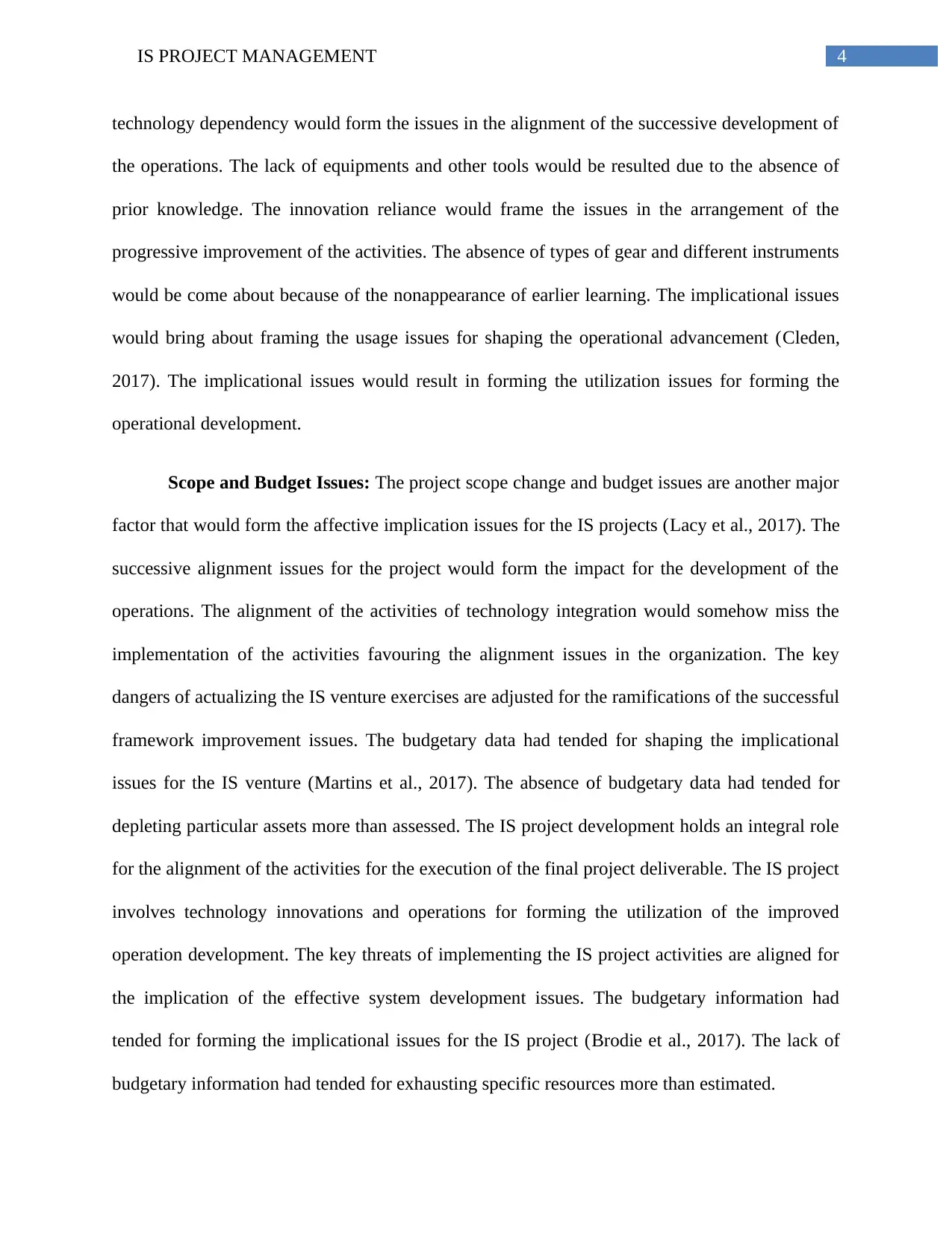
4IS PROJECT MANAGEMENT
technology dependency would form the issues in the alignment of the successive development of
the operations. The lack of equipments and other tools would be resulted due to the absence of
prior knowledge. The innovation reliance would frame the issues in the arrangement of the
progressive improvement of the activities. The absence of types of gear and different instruments
would be come about because of the nonappearance of earlier learning. The implicational issues
would bring about framing the usage issues for shaping the operational advancement (Cleden,
2017). The implicational issues would result in forming the utilization issues for forming the
operational development.
Scope and Budget Issues: The project scope change and budget issues are another major
factor that would form the affective implication issues for the IS projects (Lacy et al., 2017). The
successive alignment issues for the project would form the impact for the development of the
operations. The alignment of the activities of technology integration would somehow miss the
implementation of the activities favouring the alignment issues in the organization. The key
dangers of actualizing the IS venture exercises are adjusted for the ramifications of the successful
framework improvement issues. The budgetary data had tended for shaping the implicational
issues for the IS venture (Martins et al., 2017). The absence of budgetary data had tended for
depleting particular assets more than assessed. The IS project development holds an integral role
for the alignment of the activities for the execution of the final project deliverable. The IS project
involves technology innovations and operations for forming the utilization of the improved
operation development. The key threats of implementing the IS project activities are aligned for
the implication of the effective system development issues. The budgetary information had
tended for forming the implicational issues for the IS project (Brodie et al., 2017). The lack of
budgetary information had tended for exhausting specific resources more than estimated.
technology dependency would form the issues in the alignment of the successive development of
the operations. The lack of equipments and other tools would be resulted due to the absence of
prior knowledge. The innovation reliance would frame the issues in the arrangement of the
progressive improvement of the activities. The absence of types of gear and different instruments
would be come about because of the nonappearance of earlier learning. The implicational issues
would bring about framing the usage issues for shaping the operational advancement (Cleden,
2017). The implicational issues would result in forming the utilization issues for forming the
operational development.
Scope and Budget Issues: The project scope change and budget issues are another major
factor that would form the affective implication issues for the IS projects (Lacy et al., 2017). The
successive alignment issues for the project would form the impact for the development of the
operations. The alignment of the activities of technology integration would somehow miss the
implementation of the activities favouring the alignment issues in the organization. The key
dangers of actualizing the IS venture exercises are adjusted for the ramifications of the successful
framework improvement issues. The budgetary data had tended for shaping the implicational
issues for the IS venture (Martins et al., 2017). The absence of budgetary data had tended for
depleting particular assets more than assessed. The IS project development holds an integral role
for the alignment of the activities for the execution of the final project deliverable. The IS project
involves technology innovations and operations for forming the utilization of the improved
operation development. The key threats of implementing the IS project activities are aligned for
the implication of the effective system development issues. The budgetary information had
tended for forming the implicational issues for the IS project (Brodie et al., 2017). The lack of
budgetary information had tended for exhausting specific resources more than estimated.
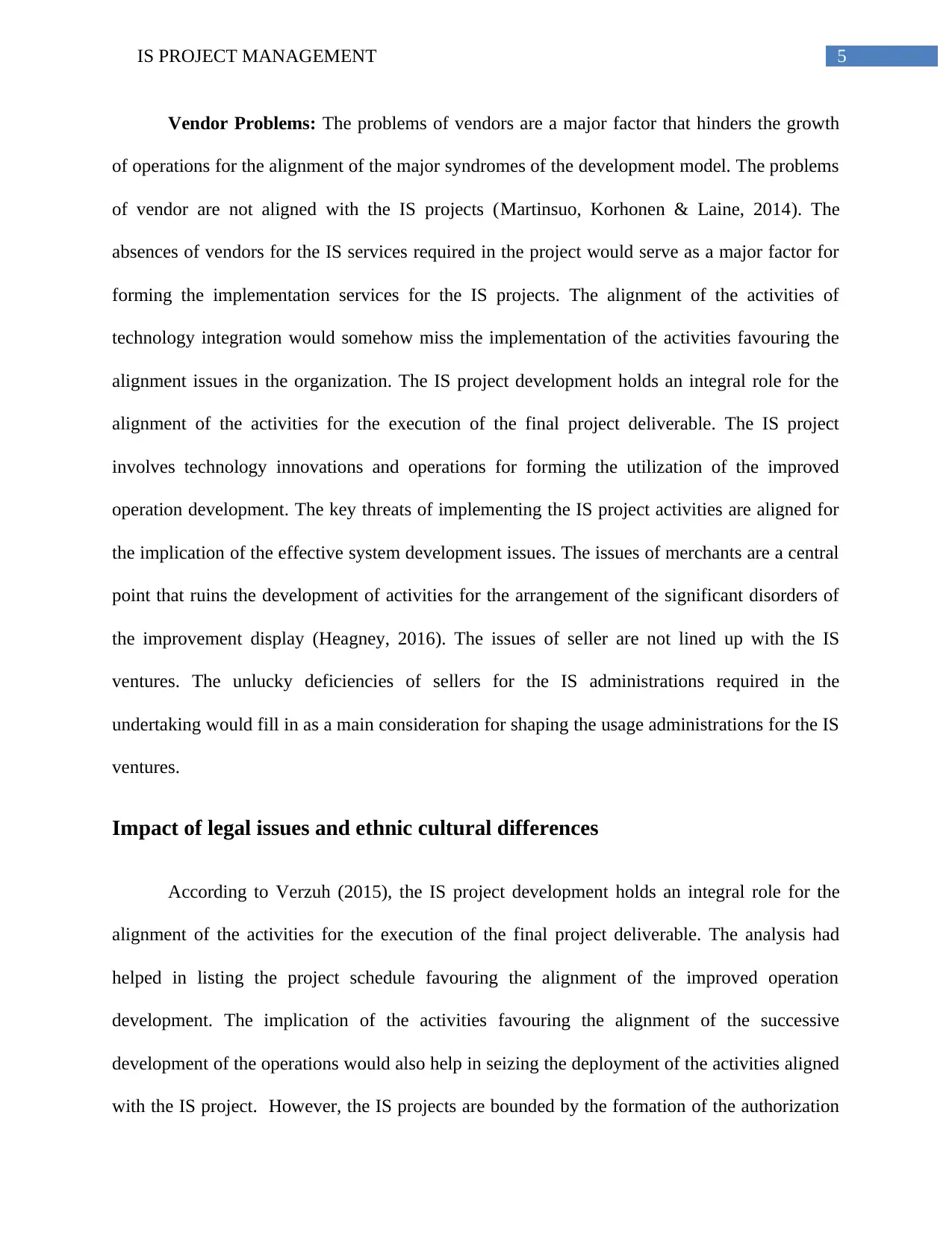
5IS PROJECT MANAGEMENT
Vendor Problems: The problems of vendors are a major factor that hinders the growth
of operations for the alignment of the major syndromes of the development model. The problems
of vendor are not aligned with the IS projects (Martinsuo, Korhonen & Laine, 2014). The
absences of vendors for the IS services required in the project would serve as a major factor for
forming the implementation services for the IS projects. The alignment of the activities of
technology integration would somehow miss the implementation of the activities favouring the
alignment issues in the organization. The IS project development holds an integral role for the
alignment of the activities for the execution of the final project deliverable. The IS project
involves technology innovations and operations for forming the utilization of the improved
operation development. The key threats of implementing the IS project activities are aligned for
the implication of the effective system development issues. The issues of merchants are a central
point that ruins the development of activities for the arrangement of the significant disorders of
the improvement display (Heagney, 2016). The issues of seller are not lined up with the IS
ventures. The unlucky deficiencies of sellers for the IS administrations required in the
undertaking would fill in as a main consideration for shaping the usage administrations for the IS
ventures.
Impact of legal issues and ethnic cultural differences
According to Verzuh (2015), the IS project development holds an integral role for the
alignment of the activities for the execution of the final project deliverable. The analysis had
helped in listing the project schedule favouring the alignment of the improved operation
development. The implication of the activities favouring the alignment of the successive
development of the operations would also help in seizing the deployment of the activities aligned
with the IS project. However, the IS projects are bounded by the formation of the authorization
Vendor Problems: The problems of vendors are a major factor that hinders the growth
of operations for the alignment of the major syndromes of the development model. The problems
of vendor are not aligned with the IS projects (Martinsuo, Korhonen & Laine, 2014). The
absences of vendors for the IS services required in the project would serve as a major factor for
forming the implementation services for the IS projects. The alignment of the activities of
technology integration would somehow miss the implementation of the activities favouring the
alignment issues in the organization. The IS project development holds an integral role for the
alignment of the activities for the execution of the final project deliverable. The IS project
involves technology innovations and operations for forming the utilization of the improved
operation development. The key threats of implementing the IS project activities are aligned for
the implication of the effective system development issues. The issues of merchants are a central
point that ruins the development of activities for the arrangement of the significant disorders of
the improvement display (Heagney, 2016). The issues of seller are not lined up with the IS
ventures. The unlucky deficiencies of sellers for the IS administrations required in the
undertaking would fill in as a main consideration for shaping the usage administrations for the IS
ventures.
Impact of legal issues and ethnic cultural differences
According to Verzuh (2015), the IS project development holds an integral role for the
alignment of the activities for the execution of the final project deliverable. The analysis had
helped in listing the project schedule favouring the alignment of the improved operation
development. The implication of the activities favouring the alignment of the successive
development of the operations would also help in seizing the deployment of the activities aligned
with the IS project. However, the IS projects are bounded by the formation of the authorization
⊘ This is a preview!⊘
Do you want full access?
Subscribe today to unlock all pages.

Trusted by 1+ million students worldwide
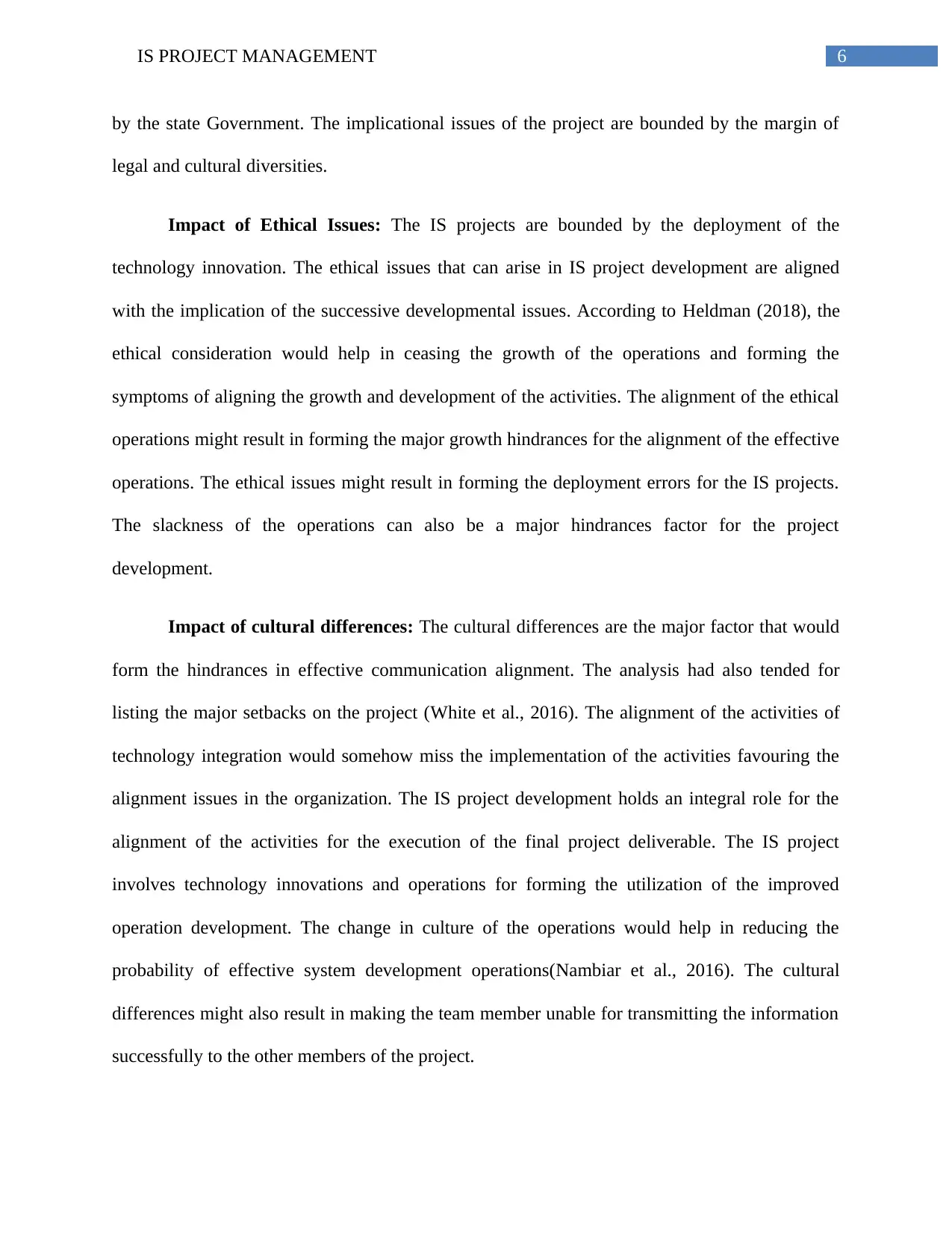
6IS PROJECT MANAGEMENT
by the state Government. The implicational issues of the project are bounded by the margin of
legal and cultural diversities.
Impact of Ethical Issues: The IS projects are bounded by the deployment of the
technology innovation. The ethical issues that can arise in IS project development are aligned
with the implication of the successive developmental issues. According to Heldman (2018), the
ethical consideration would help in ceasing the growth of the operations and forming the
symptoms of aligning the growth and development of the activities. The alignment of the ethical
operations might result in forming the major growth hindrances for the alignment of the effective
operations. The ethical issues might result in forming the deployment errors for the IS projects.
The slackness of the operations can also be a major hindrances factor for the project
development.
Impact of cultural differences: The cultural differences are the major factor that would
form the hindrances in effective communication alignment. The analysis had also tended for
listing the major setbacks on the project (White et al., 2016). The alignment of the activities of
technology integration would somehow miss the implementation of the activities favouring the
alignment issues in the organization. The IS project development holds an integral role for the
alignment of the activities for the execution of the final project deliverable. The IS project
involves technology innovations and operations for forming the utilization of the improved
operation development. The change in culture of the operations would help in reducing the
probability of effective system development operations(Nambiar et al., 2016). The cultural
differences might also result in making the team member unable for transmitting the information
successfully to the other members of the project.
by the state Government. The implicational issues of the project are bounded by the margin of
legal and cultural diversities.
Impact of Ethical Issues: The IS projects are bounded by the deployment of the
technology innovation. The ethical issues that can arise in IS project development are aligned
with the implication of the successive developmental issues. According to Heldman (2018), the
ethical consideration would help in ceasing the growth of the operations and forming the
symptoms of aligning the growth and development of the activities. The alignment of the ethical
operations might result in forming the major growth hindrances for the alignment of the effective
operations. The ethical issues might result in forming the deployment errors for the IS projects.
The slackness of the operations can also be a major hindrances factor for the project
development.
Impact of cultural differences: The cultural differences are the major factor that would
form the hindrances in effective communication alignment. The analysis had also tended for
listing the major setbacks on the project (White et al., 2016). The alignment of the activities of
technology integration would somehow miss the implementation of the activities favouring the
alignment issues in the organization. The IS project development holds an integral role for the
alignment of the activities for the execution of the final project deliverable. The IS project
involves technology innovations and operations for forming the utilization of the improved
operation development. The change in culture of the operations would help in reducing the
probability of effective system development operations(Nambiar et al., 2016). The cultural
differences might also result in making the team member unable for transmitting the information
successfully to the other members of the project.
Paraphrase This Document
Need a fresh take? Get an instant paraphrase of this document with our AI Paraphraser
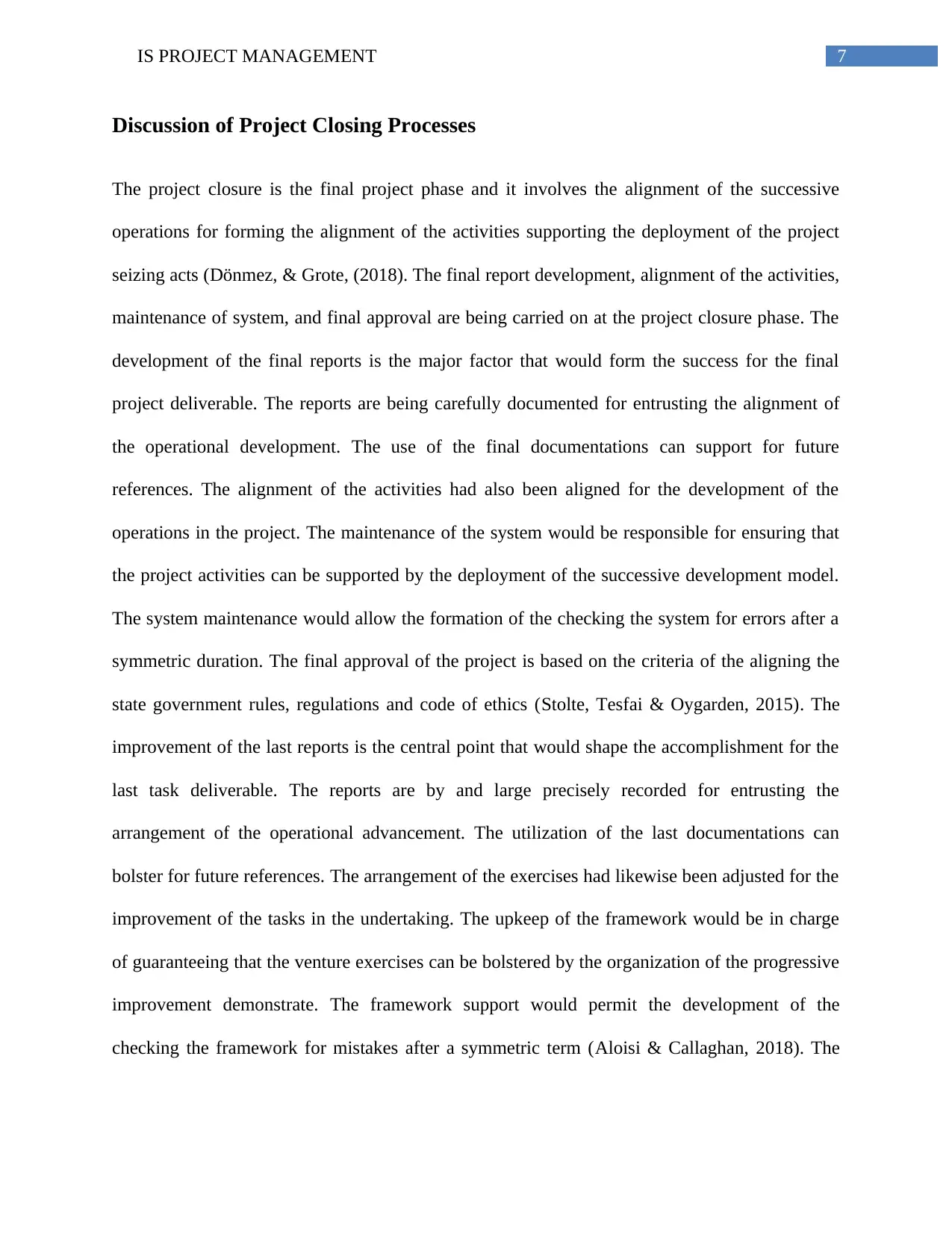
7IS PROJECT MANAGEMENT
Discussion of Project Closing Processes
The project closure is the final project phase and it involves the alignment of the successive
operations for forming the alignment of the activities supporting the deployment of the project
seizing acts (Dönmez, & Grote, (2018). The final report development, alignment of the activities,
maintenance of system, and final approval are being carried on at the project closure phase. The
development of the final reports is the major factor that would form the success for the final
project deliverable. The reports are being carefully documented for entrusting the alignment of
the operational development. The use of the final documentations can support for future
references. The alignment of the activities had also been aligned for the development of the
operations in the project. The maintenance of the system would be responsible for ensuring that
the project activities can be supported by the deployment of the successive development model.
The system maintenance would allow the formation of the checking the system for errors after a
symmetric duration. The final approval of the project is based on the criteria of the aligning the
state government rules, regulations and code of ethics (Stolte, Tesfai & Oygarden, 2015). The
improvement of the last reports is the central point that would shape the accomplishment for the
last task deliverable. The reports are by and large precisely recorded for entrusting the
arrangement of the operational advancement. The utilization of the last documentations can
bolster for future references. The arrangement of the exercises had likewise been adjusted for the
improvement of the tasks in the undertaking. The upkeep of the framework would be in charge
of guaranteeing that the venture exercises can be bolstered by the organization of the progressive
improvement demonstrate. The framework support would permit the development of the
checking the framework for mistakes after a symmetric term (Aloisi & Callaghan, 2018). The
Discussion of Project Closing Processes
The project closure is the final project phase and it involves the alignment of the successive
operations for forming the alignment of the activities supporting the deployment of the project
seizing acts (Dönmez, & Grote, (2018). The final report development, alignment of the activities,
maintenance of system, and final approval are being carried on at the project closure phase. The
development of the final reports is the major factor that would form the success for the final
project deliverable. The reports are being carefully documented for entrusting the alignment of
the operational development. The use of the final documentations can support for future
references. The alignment of the activities had also been aligned for the development of the
operations in the project. The maintenance of the system would be responsible for ensuring that
the project activities can be supported by the deployment of the successive development model.
The system maintenance would allow the formation of the checking the system for errors after a
symmetric duration. The final approval of the project is based on the criteria of the aligning the
state government rules, regulations and code of ethics (Stolte, Tesfai & Oygarden, 2015). The
improvement of the last reports is the central point that would shape the accomplishment for the
last task deliverable. The reports are by and large precisely recorded for entrusting the
arrangement of the operational advancement. The utilization of the last documentations can
bolster for future references. The arrangement of the exercises had likewise been adjusted for the
improvement of the tasks in the undertaking. The upkeep of the framework would be in charge
of guaranteeing that the venture exercises can be bolstered by the organization of the progressive
improvement demonstrate. The framework support would permit the development of the
checking the framework for mistakes after a symmetric term (Aloisi & Callaghan, 2018). The
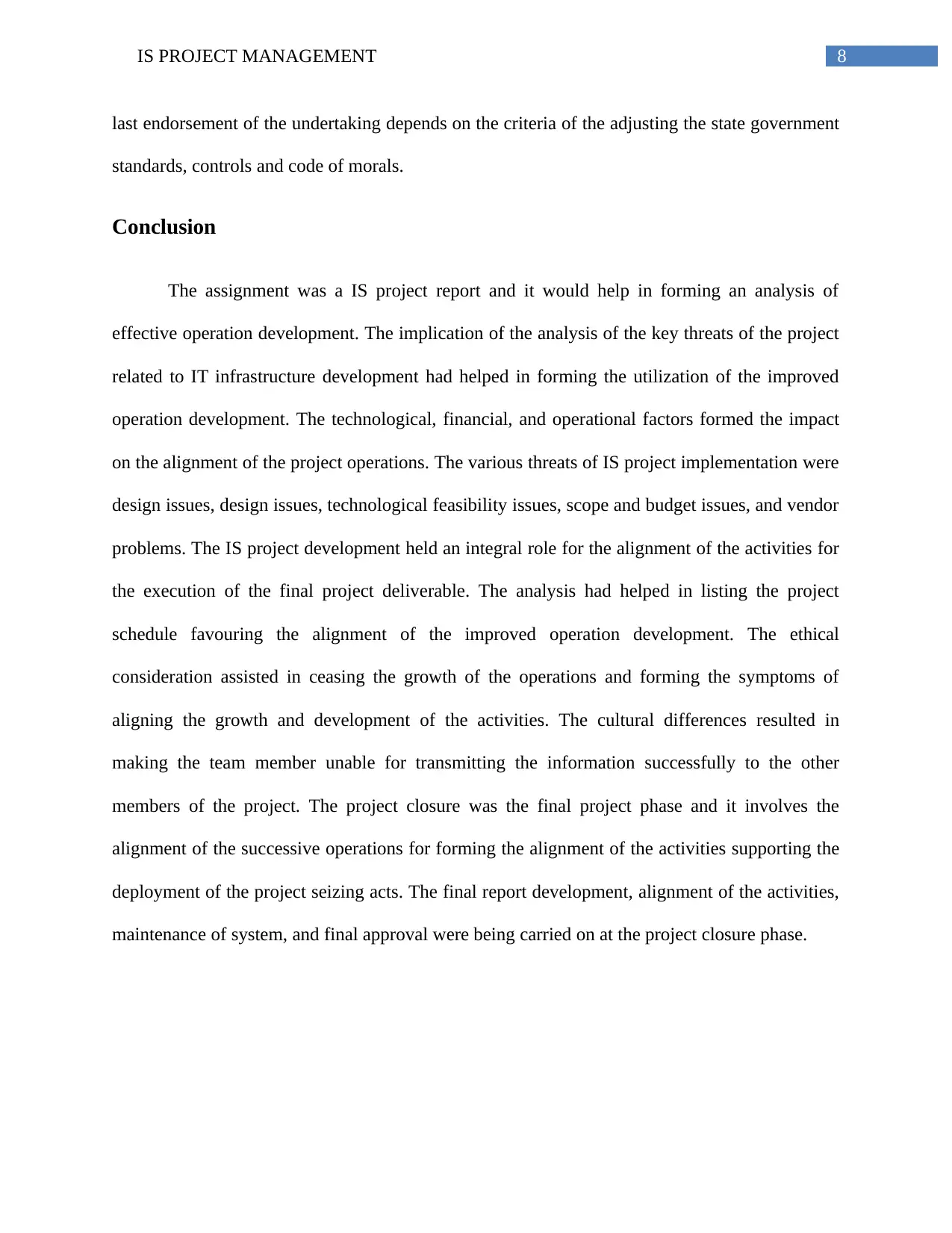
8IS PROJECT MANAGEMENT
last endorsement of the undertaking depends on the criteria of the adjusting the state government
standards, controls and code of morals.
Conclusion
The assignment was a IS project report and it would help in forming an analysis of
effective operation development. The implication of the analysis of the key threats of the project
related to IT infrastructure development had helped in forming the utilization of the improved
operation development. The technological, financial, and operational factors formed the impact
on the alignment of the project operations. The various threats of IS project implementation were
design issues, design issues, technological feasibility issues, scope and budget issues, and vendor
problems. The IS project development held an integral role for the alignment of the activities for
the execution of the final project deliverable. The analysis had helped in listing the project
schedule favouring the alignment of the improved operation development. The ethical
consideration assisted in ceasing the growth of the operations and forming the symptoms of
aligning the growth and development of the activities. The cultural differences resulted in
making the team member unable for transmitting the information successfully to the other
members of the project. The project closure was the final project phase and it involves the
alignment of the successive operations for forming the alignment of the activities supporting the
deployment of the project seizing acts. The final report development, alignment of the activities,
maintenance of system, and final approval were being carried on at the project closure phase.
last endorsement of the undertaking depends on the criteria of the adjusting the state government
standards, controls and code of morals.
Conclusion
The assignment was a IS project report and it would help in forming an analysis of
effective operation development. The implication of the analysis of the key threats of the project
related to IT infrastructure development had helped in forming the utilization of the improved
operation development. The technological, financial, and operational factors formed the impact
on the alignment of the project operations. The various threats of IS project implementation were
design issues, design issues, technological feasibility issues, scope and budget issues, and vendor
problems. The IS project development held an integral role for the alignment of the activities for
the execution of the final project deliverable. The analysis had helped in listing the project
schedule favouring the alignment of the improved operation development. The ethical
consideration assisted in ceasing the growth of the operations and forming the symptoms of
aligning the growth and development of the activities. The cultural differences resulted in
making the team member unable for transmitting the information successfully to the other
members of the project. The project closure was the final project phase and it involves the
alignment of the successive operations for forming the alignment of the activities supporting the
deployment of the project seizing acts. The final report development, alignment of the activities,
maintenance of system, and final approval were being carried on at the project closure phase.
⊘ This is a preview!⊘
Do you want full access?
Subscribe today to unlock all pages.

Trusted by 1+ million students worldwide
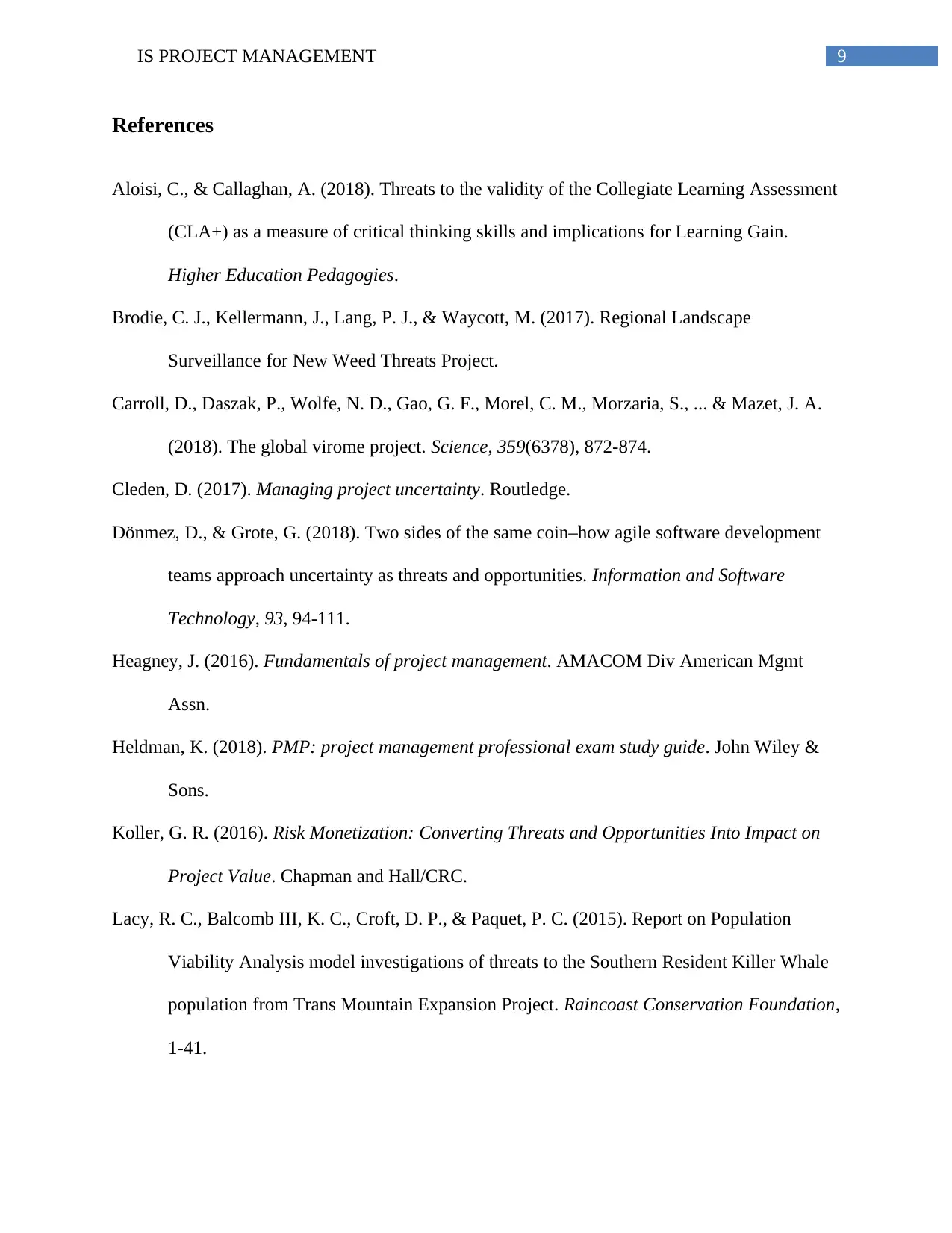
9IS PROJECT MANAGEMENT
References
Aloisi, C., & Callaghan, A. (2018). Threats to the validity of the Collegiate Learning Assessment
(CLA+) as a measure of critical thinking skills and implications for Learning Gain.
Higher Education Pedagogies.
Brodie, C. J., Kellermann, J., Lang, P. J., & Waycott, M. (2017). Regional Landscape
Surveillance for New Weed Threats Project.
Carroll, D., Daszak, P., Wolfe, N. D., Gao, G. F., Morel, C. M., Morzaria, S., ... & Mazet, J. A.
(2018). The global virome project. Science, 359(6378), 872-874.
Cleden, D. (2017). Managing project uncertainty. Routledge.
Dönmez, D., & Grote, G. (2018). Two sides of the same coin–how agile software development
teams approach uncertainty as threats and opportunities. Information and Software
Technology, 93, 94-111.
Heagney, J. (2016). Fundamentals of project management. AMACOM Div American Mgmt
Assn.
Heldman, K. (2018). PMP: project management professional exam study guide. John Wiley &
Sons.
Koller, G. R. (2016). Risk Monetization: Converting Threats and Opportunities Into Impact on
Project Value. Chapman and Hall/CRC.
Lacy, R. C., Balcomb III, K. C., Croft, D. P., & Paquet, P. C. (2015). Report on Population
Viability Analysis model investigations of threats to the Southern Resident Killer Whale
population from Trans Mountain Expansion Project. Raincoast Conservation Foundation,
1-41.
References
Aloisi, C., & Callaghan, A. (2018). Threats to the validity of the Collegiate Learning Assessment
(CLA+) as a measure of critical thinking skills and implications for Learning Gain.
Higher Education Pedagogies.
Brodie, C. J., Kellermann, J., Lang, P. J., & Waycott, M. (2017). Regional Landscape
Surveillance for New Weed Threats Project.
Carroll, D., Daszak, P., Wolfe, N. D., Gao, G. F., Morel, C. M., Morzaria, S., ... & Mazet, J. A.
(2018). The global virome project. Science, 359(6378), 872-874.
Cleden, D. (2017). Managing project uncertainty. Routledge.
Dönmez, D., & Grote, G. (2018). Two sides of the same coin–how agile software development
teams approach uncertainty as threats and opportunities. Information and Software
Technology, 93, 94-111.
Heagney, J. (2016). Fundamentals of project management. AMACOM Div American Mgmt
Assn.
Heldman, K. (2018). PMP: project management professional exam study guide. John Wiley &
Sons.
Koller, G. R. (2016). Risk Monetization: Converting Threats and Opportunities Into Impact on
Project Value. Chapman and Hall/CRC.
Lacy, R. C., Balcomb III, K. C., Croft, D. P., & Paquet, P. C. (2015). Report on Population
Viability Analysis model investigations of threats to the Southern Resident Killer Whale
population from Trans Mountain Expansion Project. Raincoast Conservation Foundation,
1-41.
Paraphrase This Document
Need a fresh take? Get an instant paraphrase of this document with our AI Paraphraser
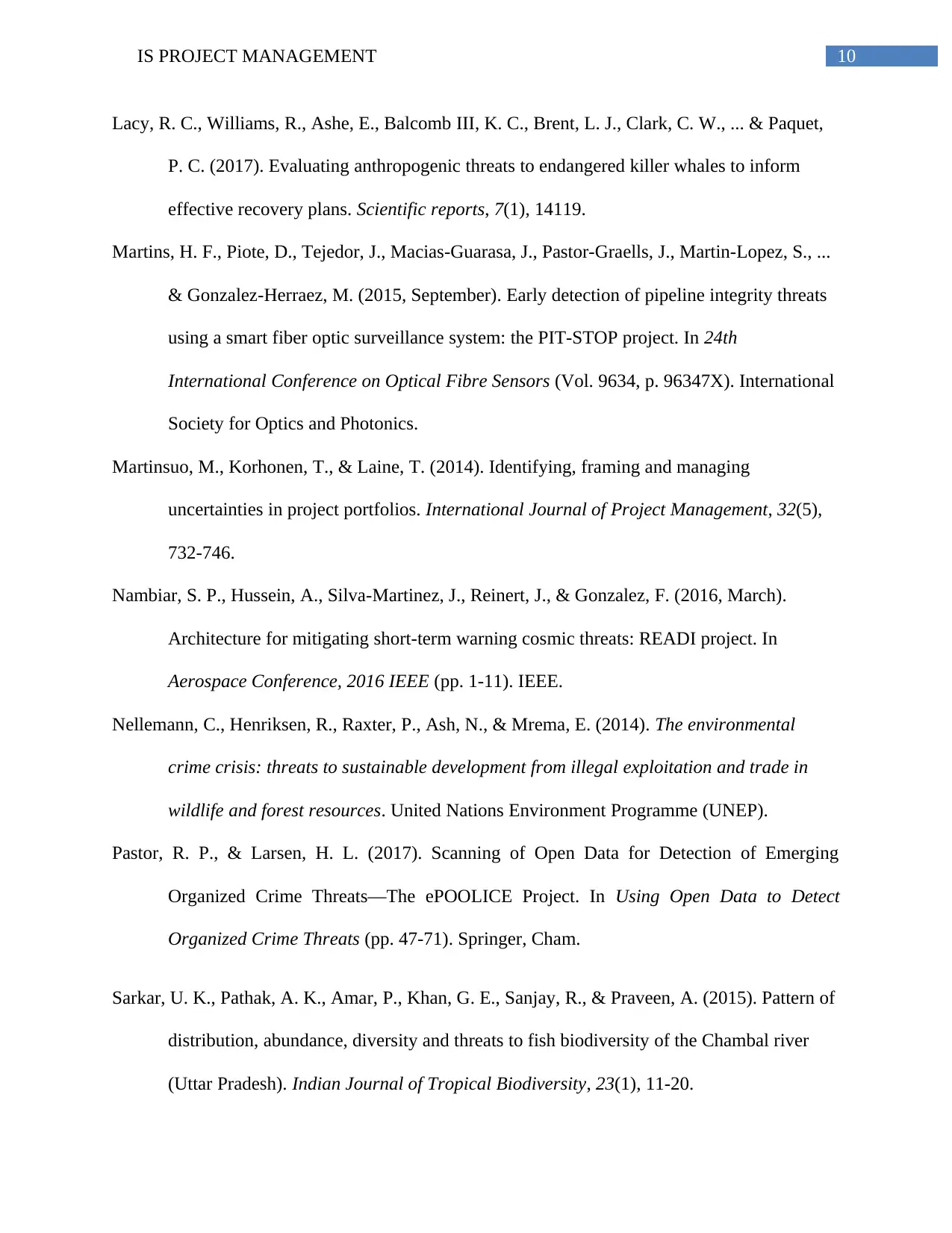
10IS PROJECT MANAGEMENT
Lacy, R. C., Williams, R., Ashe, E., Balcomb III, K. C., Brent, L. J., Clark, C. W., ... & Paquet,
P. C. (2017). Evaluating anthropogenic threats to endangered killer whales to inform
effective recovery plans. Scientific reports, 7(1), 14119.
Martins, H. F., Piote, D., Tejedor, J., Macias-Guarasa, J., Pastor-Graells, J., Martin-Lopez, S., ...
& Gonzalez-Herraez, M. (2015, September). Early detection of pipeline integrity threats
using a smart fiber optic surveillance system: the PIT-STOP project. In 24th
International Conference on Optical Fibre Sensors (Vol. 9634, p. 96347X). International
Society for Optics and Photonics.
Martinsuo, M., Korhonen, T., & Laine, T. (2014). Identifying, framing and managing
uncertainties in project portfolios. International Journal of Project Management, 32(5),
732-746.
Nambiar, S. P., Hussein, A., Silva-Martinez, J., Reinert, J., & Gonzalez, F. (2016, March).
Architecture for mitigating short-term warning cosmic threats: READI project. In
Aerospace Conference, 2016 IEEE (pp. 1-11). IEEE.
Nellemann, C., Henriksen, R., Raxter, P., Ash, N., & Mrema, E. (2014). The environmental
crime crisis: threats to sustainable development from illegal exploitation and trade in
wildlife and forest resources. United Nations Environment Programme (UNEP).
Pastor, R. P., & Larsen, H. L. (2017). Scanning of Open Data for Detection of Emerging
Organized Crime Threats—The ePOOLICE Project. In Using Open Data to Detect
Organized Crime Threats (pp. 47-71). Springer, Cham.
Sarkar, U. K., Pathak, A. K., Amar, P., Khan, G. E., Sanjay, R., & Praveen, A. (2015). Pattern of
distribution, abundance, diversity and threats to fish biodiversity of the Chambal river
(Uttar Pradesh). Indian Journal of Tropical Biodiversity, 23(1), 11-20.
Lacy, R. C., Williams, R., Ashe, E., Balcomb III, K. C., Brent, L. J., Clark, C. W., ... & Paquet,
P. C. (2017). Evaluating anthropogenic threats to endangered killer whales to inform
effective recovery plans. Scientific reports, 7(1), 14119.
Martins, H. F., Piote, D., Tejedor, J., Macias-Guarasa, J., Pastor-Graells, J., Martin-Lopez, S., ...
& Gonzalez-Herraez, M. (2015, September). Early detection of pipeline integrity threats
using a smart fiber optic surveillance system: the PIT-STOP project. In 24th
International Conference on Optical Fibre Sensors (Vol. 9634, p. 96347X). International
Society for Optics and Photonics.
Martinsuo, M., Korhonen, T., & Laine, T. (2014). Identifying, framing and managing
uncertainties in project portfolios. International Journal of Project Management, 32(5),
732-746.
Nambiar, S. P., Hussein, A., Silva-Martinez, J., Reinert, J., & Gonzalez, F. (2016, March).
Architecture for mitigating short-term warning cosmic threats: READI project. In
Aerospace Conference, 2016 IEEE (pp. 1-11). IEEE.
Nellemann, C., Henriksen, R., Raxter, P., Ash, N., & Mrema, E. (2014). The environmental
crime crisis: threats to sustainable development from illegal exploitation and trade in
wildlife and forest resources. United Nations Environment Programme (UNEP).
Pastor, R. P., & Larsen, H. L. (2017). Scanning of Open Data for Detection of Emerging
Organized Crime Threats—The ePOOLICE Project. In Using Open Data to Detect
Organized Crime Threats (pp. 47-71). Springer, Cham.
Sarkar, U. K., Pathak, A. K., Amar, P., Khan, G. E., Sanjay, R., & Praveen, A. (2015). Pattern of
distribution, abundance, diversity and threats to fish biodiversity of the Chambal river
(Uttar Pradesh). Indian Journal of Tropical Biodiversity, 23(1), 11-20.
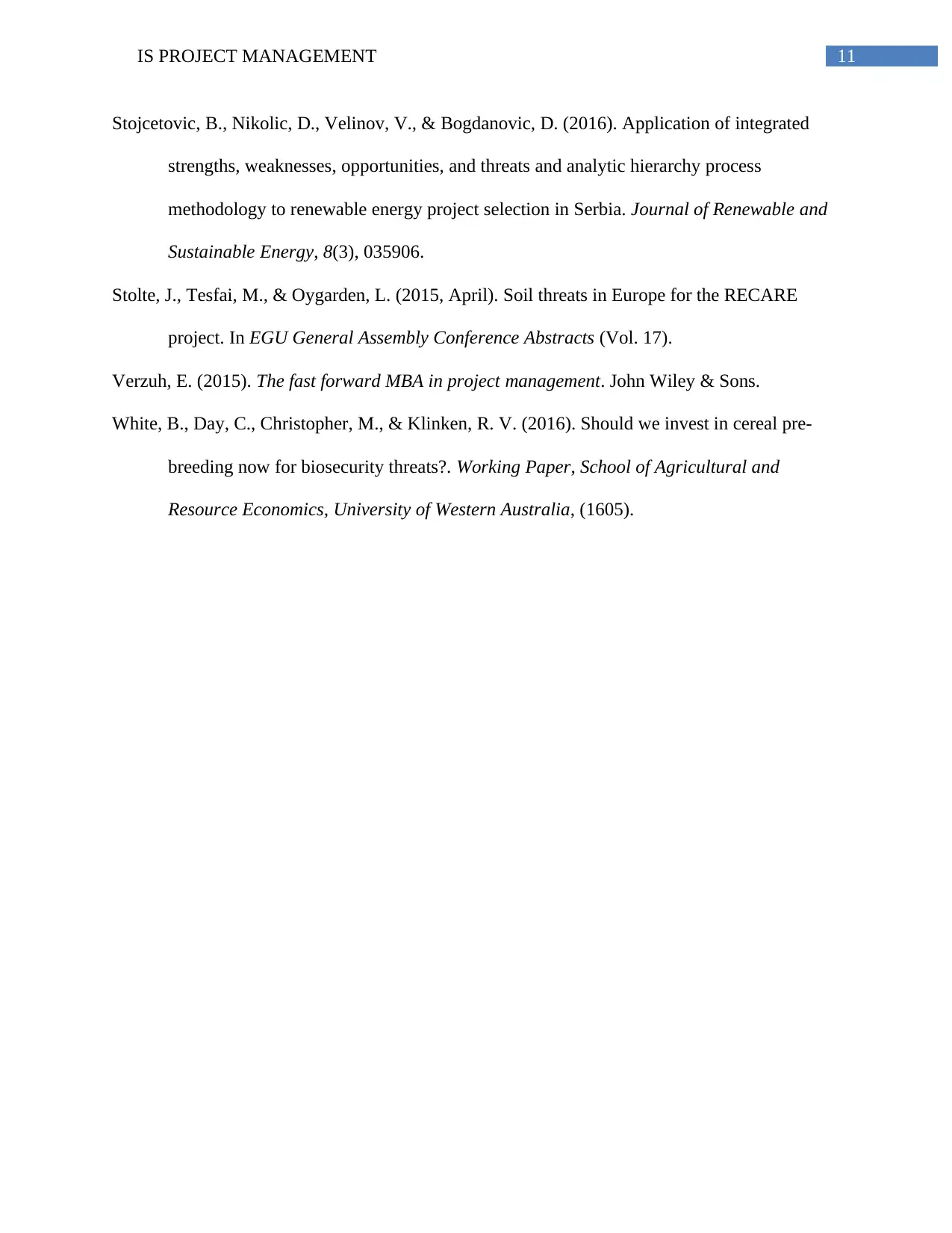
11IS PROJECT MANAGEMENT
Stojcetovic, B., Nikolic, D., Velinov, V., & Bogdanovic, D. (2016). Application of integrated
strengths, weaknesses, opportunities, and threats and analytic hierarchy process
methodology to renewable energy project selection in Serbia. Journal of Renewable and
Sustainable Energy, 8(3), 035906.
Stolte, J., Tesfai, M., & Oygarden, L. (2015, April). Soil threats in Europe for the RECARE
project. In EGU General Assembly Conference Abstracts (Vol. 17).
Verzuh, E. (2015). The fast forward MBA in project management. John Wiley & Sons.
White, B., Day, C., Christopher, M., & Klinken, R. V. (2016). Should we invest in cereal pre-
breeding now for biosecurity threats?. Working Paper, School of Agricultural and
Resource Economics, University of Western Australia, (1605).
Stojcetovic, B., Nikolic, D., Velinov, V., & Bogdanovic, D. (2016). Application of integrated
strengths, weaknesses, opportunities, and threats and analytic hierarchy process
methodology to renewable energy project selection in Serbia. Journal of Renewable and
Sustainable Energy, 8(3), 035906.
Stolte, J., Tesfai, M., & Oygarden, L. (2015, April). Soil threats in Europe for the RECARE
project. In EGU General Assembly Conference Abstracts (Vol. 17).
Verzuh, E. (2015). The fast forward MBA in project management. John Wiley & Sons.
White, B., Day, C., Christopher, M., & Klinken, R. V. (2016). Should we invest in cereal pre-
breeding now for biosecurity threats?. Working Paper, School of Agricultural and
Resource Economics, University of Western Australia, (1605).
⊘ This is a preview!⊘
Do you want full access?
Subscribe today to unlock all pages.

Trusted by 1+ million students worldwide
1 out of 12
Related Documents
Your All-in-One AI-Powered Toolkit for Academic Success.
+13062052269
info@desklib.com
Available 24*7 on WhatsApp / Email
![[object Object]](/_next/static/media/star-bottom.7253800d.svg)
Unlock your academic potential
Copyright © 2020–2025 A2Z Services. All Rights Reserved. Developed and managed by ZUCOL.




